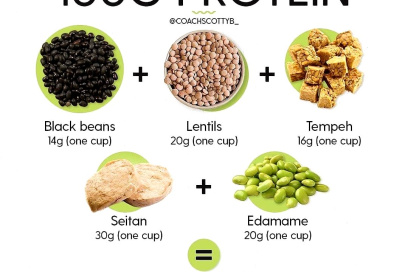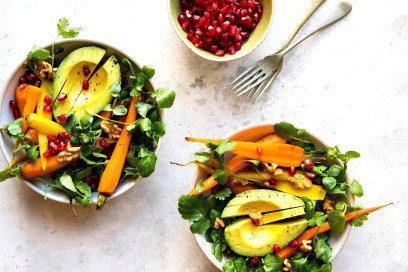Iron, a vital mineral which plays an essential role in our overall health and wellbeing, has become the subject of much discussion recently. Why, you ask? Iron is key in producing red blood cells, responsible for transporting oxygen throughout our bodies and keeping us alive and well. Without it, production would cease. Now, animal-based sources of iron may be abundant and readily accessible; the difficulty lies in meeting daily iron requirements through plant-based diet. Thus, an age-old question: "How do vegans get iron?" has plagued vegans searching for plant-based sources.
Nature vs. nurture debate is often won by nurture as we explore how a nutritious vegan diet can provide our bodies with enough iron for proper functioning. We will examine various plant-based sources of iron while discovering optimal methods of absorption; eventually equipping you with everything needed to sustain an incredible vegan diet full of iron-rich foods!
I. Plant-based Sources of Iron
Vegans need iron in their diet in order to meet their essential mineral needs, and these are some effective plant-based sources:
1. Dark Leafy Greens
Vegan connoisseurs can find an abundance of iron in spinach, kale, collard greens and broccoli if they know where to look. These vegetables are also rich in other essential vitamins, minerals, and fibre. For instance, a cup of cooked spinach provides about 6mg of iron, which is about one-third of what's recommended daily for adults. For maximum absorption, it should also be combined with vitamin C-rich foods like oranges and strawberries.
2. Legumes
Legumes are another great source of iron for vegans, particularly lentils, chickpeas, black beans and kidney beans. Incorporating legumes into soups, stews, salads or curries is an easy way to reach the recommended daily iron intake for adults.
3. Whole Grains
Quinoa, oats, millet and brown rice offer vegans a variety of whole grains rich in iron. These nutritious options also contain fibre, protein and B vitamins, providing sustained energy and keeping you feeling satisfied for longer. Additionally, fortified breakfast cereals provide quick and convenient sources of iron.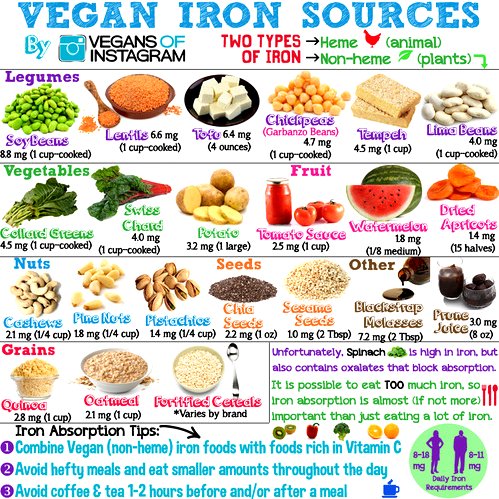
4. Nuts and Seeds
To get an extra dose of iron, nuts and seeds like squash seeds, chia seeds, almonds, and cashews offer plenty of fats, proteins and fibre. Perfect additions to salads, sandwiches or smoothies or just to snack on their delicious crunchiness!
5. Tofu and Soy Products
Try tempeh and edamame as options that contain tofu or soy products like tempeh with 6mg per half-cup of firm tofu for those looking for something with plenty of iron. These vegan-friendly alternatives also boast high protein content, making them great sources of nutrition.
Importantly, vegans must remember that plant-based sources may absorb iron less efficiently than animal sources; however, this does not preclude reaching their daily recommended iron intake through vegetarian food alone; proper planning and food pairing strategies will enable a vegan diet to provide enough dietary iron.
II. Plant-based Sources of Iron
Establishing an iron-rich plant-based diet is both essential and integral. But for maximum benefit, your body must also absorb as much iron from these sources as possible. Here are a few strategies you can employ to increase iron absorption:
Vitamin C Pairing
Consuming iron-rich foods alongside those containing abundant amounts of Vitamin C could aid the absorption of iron. According to scientists, vitamin C transforms non-heme iron found in plant sources into something the body can easily absorb; such as citrus fruits, strawberries, bell peppers, and tomatoes which all provide plenty of Vitamin C!
Threshold Exposure
When consuming meals rich in iron, be wary of teas or coffee that contain tannins as this could inhibit absorption into your body. Water or non-caffeinated drinks could also provide alternatives.
Soaking, Sprouting or Fermenting
Preparing meals using these cooking methods will significantly enhance the bioavailability of iron. Soaking any grains or legumes prior to cooking them helps decrease levels of phytates that act as barriers for iron absorption, while sprouting or fermenting these same grains and legumes breaks down these same phytates further and increases iron quantity and accessibility.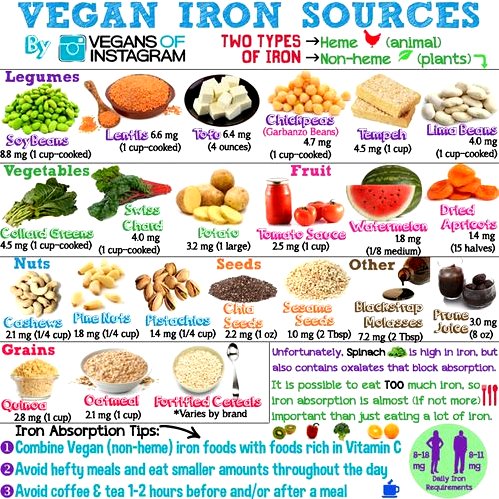
Cooking Prep
Another strategy for optimizing iron absorption is cooking with cast iron cookware. Acidic dishes, such as spaghetti sauce or chili, when made in this format may increase their iron absorption rates significantly, especially those naturally low in iron content.
Calcium Consumption
Timing and method of consumption are critical in optimizing iron absorption. It is best to take calcium supplements at different times during the day than meals to limit their interference with absorption; otherwise combining calcium-rich foods with iron-rich ones could be unhealthy dietary choices.
By following these tips diligently, an increase in plant-based iron absorption can be achieved, providing increased satisfaction and fulfillment from your diet with optimal results.
Learn more at Purely Planted about plant-based sources of iron.III. Maximizing Iron Absorption
Vegans face particular difficulties with non-heme iron and supplements. Their bodies cannot readily absorb it as effectively as with animal-sourced heme iron, so vegans must be extra vigilant about seeking out non-heme iron-rich foods in their diet - however there are plenty of non-heme iron options available that won't disappoint their palate:
Blackstrap Molasses
Blackstrap molasses is the highest source of non-heme iron available for vegan consumption; just one tablespoon contains approximately 1.8 mg.
Fortified Foods
Fortified foods may also be suitable, provided one pays close attention to food labels and looks for products made especially for vegan diets. Fortified products come in all forms from cereal to milk alternatives - any added iron works well with your specific dietary requirements.
Dried Fruits
Dried fruits such as apricots, figs, raisins and prunes contain non-heme iron in abundance, while being extremely high in fiber content with other essential vitamins and nutrients as well.
Hemp Seeds
Hemp seeds offer another solution for getting non-heme iron; their excellent concentration of non-heme iron is only one part of their many nutritional qualities; these tiny seed pods contain protein, omega-3 fatty acids, vitamins and minerals - perfect for salads, smoothies or munching outright - take your pick!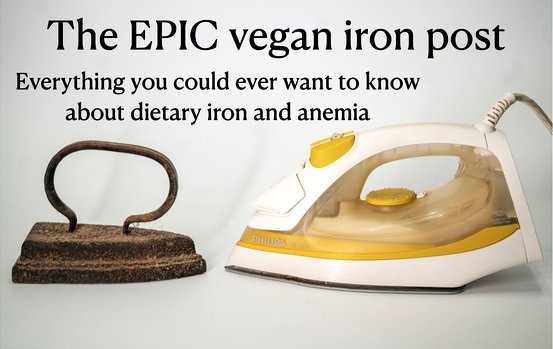
Iron Supplements
Iron supplements may provide an answer for those struggling to incorporate enough non-heme iron into their diet, however it would be prudent for anyone considering supplementation to consult their healthcare professional prior to popping any capsules. Iron supplements carry some risk for constipation so please respect recommended dosage amounts from health experts.
Meet Your Daily Non-Heme Iron Requirements
Don't worry vegan readers: meeting daily non-heme iron requirements doesn't need to be an impossible feat! With the proper food choices and optimal iron absorption techniques (plus supplements if necessary), veganism and iron intake go hand-in-hand beautifully!
Learn more about Maximizing Iron Absorption on Healthline.IV. Non-Heme Iron Foods and Iron Supplements
As you strive to increase your iron absorption, consider pairing iron-rich foods with other highly complementary options that could boost its absorption. Here are five dazzling food combinations that could increase it:
1. Legumes with Brown Rice
Did you know that pairing one cup of nutrient-rich legumes, such as lentils or chickpeas with high phytate foods like brown rice can increase iron absorption? While brown rice contains significant quantities of phytic acid that prevents iron absorption, when combined with vitamin C-rich legumes it acts as a neutralizer, increasing iron absorption rates by about 25%.
2. Spinach Salad with Citrus Dressing
Unleash the iron-rich spinach by pairing it with citrus-based dressing. Simply toss some into your salad bowl and drizzle some citrus juice over it - this will significantly enhance iron absorption since vitamin C in citrus increases its uptake process.
3. Tofu with Broccoli
Give your taste buds something deliciously vegan by pairing tofu and broccoli together. In addition to being an excellent source of iron, tofu becomes even more impressive when combined with broccoli as its vitamin C-rich nature can enhance iron absorption even further.
4. Lentil Soup with Tomatoes
Looking for an effective vegan way to increase their iron stores without breaking the bank? Consider mixing up a warm bowl of lentil soup with vitamin C-packed tomatoes as it provides the perfect combination for an iron absorption boost. The combination of iron-rich lentils with vitamin C-packed tomatoes creates the ideal formula for successful iron absorption.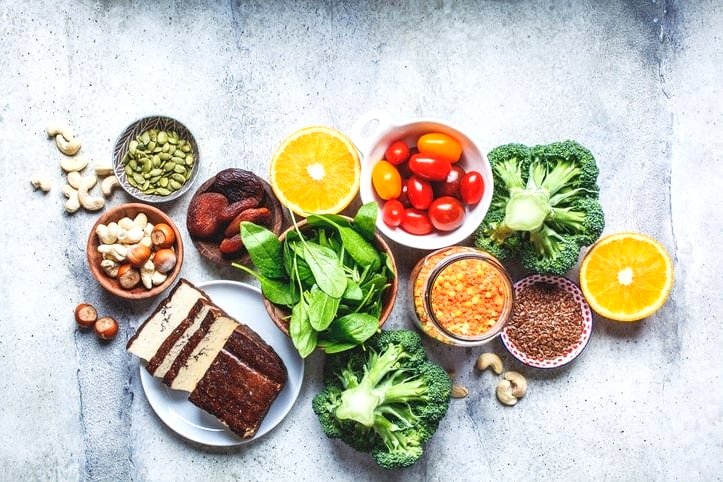
5. Oatmeal with Almond Butter and Berries
Give yourself a boost each morning with this plant-based triple combo that provides iron, vitamin C, healthy fats and proteins all in one package! Combine iron-rich oats, almond butter and berries into one bowl and watch as your iron absorption soars with increased levels of vitamin C running through your veins!
As a vegan, your body can make the most of its plant-based diet by pairing iron-rich foods with highly complementary options that ensure optimal iron absorption. By creating some truly exciting combinations of foods, you can be certain of optimal iron absorption.
- Keywords: iron absorption, vegan, plant-based, nutrient-rich, phytate, vitamin C, delicious, cost-effective, lentils, tomatoes, almond butter, berries, healthy fats, proteins
- SEO Title: 5 Dazzling Ways to Increase Your Iron Absorption as a Plant-Based Eater
- Meta Description: Are you struggling to increase your iron absorption on a plant-based diet? Discover five delicious and cost-effective food combinations that could boost your iron intake along with some tips for better iron absorption.
Conclusion:
Reaching your daily recommended iron intake as a vegan may seem an impossible feat, yet we must recognize its insurmountability. Implementing an array of iron-rich plant sources into their diet, with an eye towards optimizing absorption and supplementation can enable vegans to meet their iron needs and maintain a diet which provides both balance and health benefits. Individuals should strive to incorporate foods that provide high iron levels into their diet, such as dark leafy greens, legumes, whole grains, nuts, seeds, and tofu into their meals for maximum iron absorption. Vitamin C-enriched foods may be particularly helpful. As well, one may employ various cooking methods such as soaking, sprouting and fermenting grains and legumes; using cast iron cookware; and forgoing tea and coffee during meals. Finally, supplementation could be considered to ensure you meet your daily recommended iron intake requirements.


